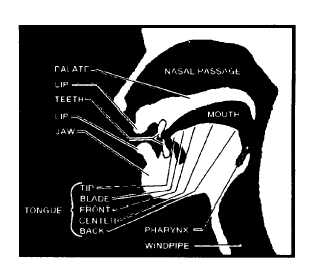trainees exaggerate the speaking movements, making
sure to use the jaw, mouth, lips and tongue to
overarticulate each word in the same sentences. Play the
tape back to let them hear the difference.
Here is another exercise for you to use for general
voice training. First, while in a sitting position, have
them say the sentences aloud in a normal speaking
voice. Second, again stand comfortably erect and direct
them to say the sentences aloud. As they breathe, have
them try to keep most of the movement in the center of
their bodies. Place the trainees’ hands on their
waistlines, with their fingers extending to the front and
their thumbs to the rear. They should feel the expansion
in this area. Third, have them place a book against their
stomachs. Direct them to inhale. Notice how the
expansion of their stomachs forces the book out from
1/4 to 3/4 inch. Exhale. The contraction in the trainees’
stomachs permits the books to go back in. Let them get
the feel of this action. Have them repeat the exercise
while concentrating on their breathing.
VOCAL QUALITY
The announcer’s voice is not the only part of the
announcer. It implies the whole announcer and is a
product of not only the physical self but also the
emotional and mental being. The voice can be taught to
be more effective through training of those muscles that
cause it to be weak metallic, harsh, breathy or nasal in
quality, and to those mental or emotional characteristics
that provoke the voice to be grating, melancholy or cold
in tone. The announcer’s muscles and mental attitude
must function collectively with precision, accuracy and
ease. All of these elements are responsible for the
fundamentals of speech.
RESONANCE
When you start to speak, the first vocal tones are
dull and weak. The sounds must be enhanced and given
color to be heard. The color or quality of the voice
denotes richness and emotional meaning. The vocal
loudness and changes that happen within the cavities of
the human voice are known as resonance. The two types
of resonance are sounding board and cavity.
A vibrating tuning fork held free cannot be heard by
the ear with ease except at a short distance. However,
when you hold its stem against a solid object, the tone
will be heard throughout a room. This is because the
tuning fork and the solid object vibrate in unison, or
together, with the exact number of vibrations of the
tuning fork. The tone increases because the size of the
vibrator, the solid object, has been increased. The sound
quality of the louder tone changes from solid object to
solid object, depending on the size and its composition.
This is sounding board resonance. A musical instrument
that uses the theory of sounding board resonance is the
violin. If you were to hold a tuning fork inside an open
pipe and cup your hand over that end, the tone is
amplified and sent through the other end. The enclosed
column of air is set to vibrating sympathetically and the
focus resulting from the enclosure produces ampli-
fication. Again, the quality of sound varies with the
composition of the pipe; that is, brass, copper, and so
forth. The quality of sound depends on the size of the
pipe, its length, diameter, shape, openings and internal
makeup. This is an example of cavity resonance. The
saxophone is another. The three main cavity resonators,
or pipes, of the voice are the throat, mouth and nose.
All three are located above the main vibrators–the
vocal cords. The mouth is the most variable of the three,
while the nose and sinus cavity are the least variable of
the cavity resonators. Beneath the vibrators are the
invariable vibrators–the windpipe and bronchial tubes
which, according to their size, openness and health, may
emphasize certain overtones (see fig. 8-19). Because
they are fixed and untrainable, you must keep them
physically fit.
The bones, cartilage and muscles of the chest cavity,
neck and head are the sounding boards of a person’s
voice. During speech, they vibrate in varying degrees
and alter sound, loudness and selection of overtones.
These, also, you must keep physically fit. Keep the
throat open, detached of unnecessary tension and with
enough flexibility to react to any type or subtlety of
feeling. This means that your talking with a smile really
Figure 8-19.—Articulatory organs and resonance cavities.
8-40

